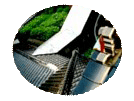Lotus in the fire
Shôshintanza - Sitting upright |
Sitting upright
Dogen Zenji writes in the Zazengi chapter of the Shobogenzo:
Sit upright in the proper position. Lean neither to the left nor to the right, neither forward nor backward. Your ears should be in line with your shoulders; your nose in line with your navel.
When you sit with your legs crossed, both knees firmly on the floor, your buttocks resting on the cushion, the lower half of your body should be stable like the base of a pyramid (or, to be more precise, a tetrahedron) supporting the upper upper body. For this, it is important that the pelvis is bend forward, so that the weight of the upper body does not rest on the buttocks alone, but on the threes corners of the tetrahedron's base which are formed by the buttocks and the two knees. The exact way how to do this is explained in my article on the Hips from 2009.
Sawaki Roshi has the following to say:
"Place your behind on the zafu, taking care not to use more than half of it. Don't sit on the full cushion. Your zafu is just as important for your zazen as is the sword for a samurai. It is important that it has the right size and height for your body...
Your knees should rest firmly on the mat, just like shells that attach themselves to a rock in the ocean...
Push your lower back forward and the behind so far back that your anus points straight backwards. Resting on your hip bone, your spine should be straight and unmoving...
Make sure that your hips are always bend forward and your consciousness sharp and clear. Don't forget that the vital point of zazen lies in the hip/waist/pelvis area."
When the pelvis is pushed slightly forward,
the five lowest vertebrae which form the lumbar curve will also be tilted forward. Although Sawaki Roshi comments that the spine should be "straight and unmoving", the backbone naturally forms an S-curve,which is also the case during zazen. But subejectively, it should feel as if the spine was indeed perfectly straight and upright, stable and calm as a big mountain.
Sawaki Roshi goes on to comment that
"Stretch your neck as if you tried to pierce with your skull through the ceiling. Draw back the chin until the skin behind your ears starts to hurt. "

|
As I tried to show in the article How to sit 2 from 2005, these instructions are completely over the top. You will not pierce through the ceiling no matter how much you push upward, nor should the skin behind your ears start hurting. On the other hand, there should defenintely be a certain, natural tension in the physical posture. Do not sit there like a bag of rice, or as Sawaki Roshi would put it: "Don't make such a sleepy face - you look like a ball of cotton wool!"
Here you see me trying to give an example of how the posture should (left) and should not (right) look. Even though the pelvis is bend forward and the spine iks stretched upward, it should feel as if the whole body is resting comfortably, each part in its place. |

|
|
Your shoulders should be completely relaxed, and your elbows held a little away from the trunk. If the arms and elbows are too close to the trunk, this will result in tension in the shoulders and it will also be difficult to uphold the Hokkaijoin-mudra of the hands. How far should the elbows be removed from the trunk? Imagine your were holding an ostrich egg between your arm and upper body. If you hold the elbow too tight to the trunk, the egg will break. It the elbow is too far, the egg will fall. Try to support the virtual egg at the same time as softly and safely as you can. |
|
So, if you have the privilege of someone correcting you in a sitting group, it will usually feel like: "What is he doing!? I was sitting straight, and he is bending my spine in a funny direction!"
Most likely, the posture you were sitting in before was the "funny" one. But because of lifelong habits, your internal sensor had become used to it and registers it as "normal". When it is corrected to a normal, straight posture, it feels "funny" to your internal sensor, but that is not because the posture is funny, but because the adjustment of your sensor is funny. It takes years of practice to re-adjust that sensor, and during those years, you will need an external point of reference. Preferably regular contact with a living teacher, or if you can not get one, at least a mirror.
[Muho]
| <<< Previous article | Contents | Next article >>> |
